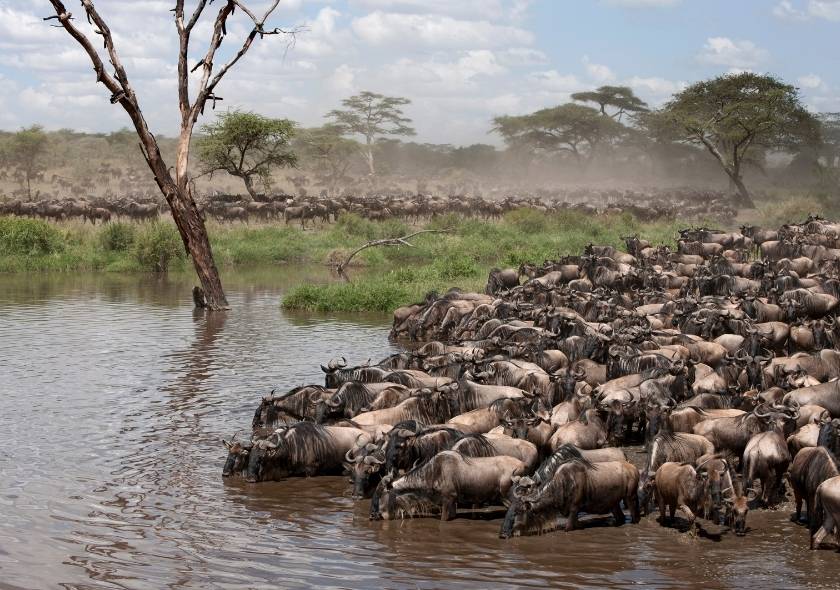
On the search for fresh grass to graze & water, millions of animals trek this route, making it the largest animal migration on Earth (& quite the bucket list adventure)
When it comes to wildlife spectacles, few experiences can rival the awe-inspiring Great Migration. It is one of the most spectacular sights in the natural world. It's a journey of survival, a testament to the resilience of wildlife, and a must-see for any nature lover.
If you’re planning to witness this natural phenomenon, here's everything you need to know about the best time to visit, where to witness it, and what makes it so special.
The Great Migration is one of the largest and most spectacular natural events on Earth. Every year, over 1.5 million wildebeest, along with hundreds of thousands of zebras and gazelles, migrate across the Serengeti in Tanzania and the Masai Mara in Kenya in search of food and water. Spanning more than 1,800 miles, this migration is driven by the rains, showcasing the resilience and interconnectedness of nature.
What makes it special is its unpredictability. The journey is dangerous, from river crossings packed with Nile crocodiles to predators like lions, leopards, and hyenas. This intense struggle for survival makes the Great Migration an exhilarating experience to witness.
The migration is also vital to the ecosystem. As these animals graze and move, they rejuvenate the soil, supporting a variety of plant and animal species. The migration, therefore, is a cycle that sustains not only the animals, but the very life of the savannah.
Read More: What You Should Know Before Booking a Group Safari
When planning your safari, selecting the right destination is key to maximizing your chances of witnessing this exciting event. Here are some top destinations that offer prime views of the Great Migration.
The Serengeti is the heart of the Great Migration, offering incredible views of the event. Depending on the season, visitors can witness different stages of the migration, from calving season to dramatic river crossings. The Serengeti is particularly famous for the Grumeti and Mara river crossings, where wildebeest face crocodile-infested waters.
The Masai Mara offers excellent game viewing during the drier months of July to October when large herds of wildebeest thunder across its plains. The Mara's smaller size makes it easier to witness the migration, and its abundance of luxury lodges and camps makes it a popular safari destination.
While less associated with the Great Migration, Ngorongoro is worth a visit for its unique ecosystem. The crater is home to lions, elephants, and even rare black rhinos. During the calving season, wildebeest often pass through Ngorongoro, making it an ideal spot to witness the birth of new life and predator-prey interactions.

While the migration is a year-round event, different stages occur at different times and locations. Here’s a breakdown of when and where to go:
This is the time to see the beginning of the cycle of life in the wild. Between January and March, over 500,000 wildebeest calves are born on the southern plains. With the abundance of young calves, predators such as lions and cheetahs are never far behind, making this period ideal for thrilling game viewing.
During this phase, herds begin moving north in search of fresh grazing land as the rains start in the central Serengeti. Although the river crossings haven’t yet begun, this is a great time to experience the migration with fewer crowds.
This is the peak season for witnessing dramatic river crossings, particularly in the northern Serengeti and Masai Mara. Wildebeest plunge into the Mara River, facing the perils of strong currents and waiting crocodiles. This heart-pounding spectacle is what most visitors come to see.
By November, the herds begin to migrate south back to the Serengeti, completing the cycle. This is a quieter time to visit, with fewer tourists, but still plenty of wildlife action as the wildebeest prepares for the next calving season.

Selecting the right safari experience depends on your preferences and budget. Whether you want to camp under the stars or relax in a luxurious lodge, there are plenty of options to cater to every type of explorer.
Timing your visit right and choosing the best destinations will ensure you get the most out of your safari adventure. So, pack your bags, charge your camera, and get ready to witness one of nature’s greatest shows with Good Earth Tours- your responsible travel partner!
